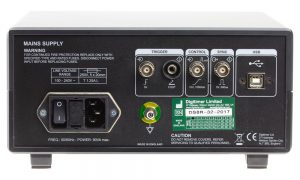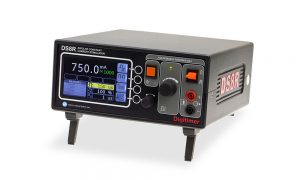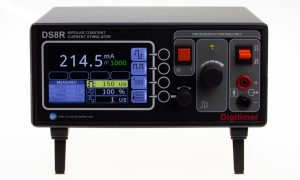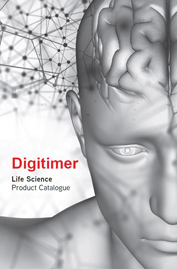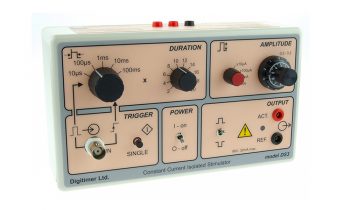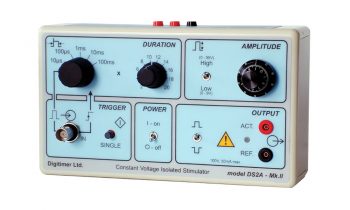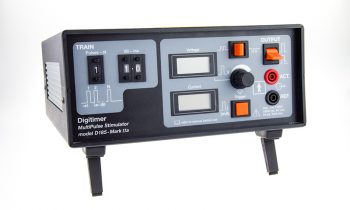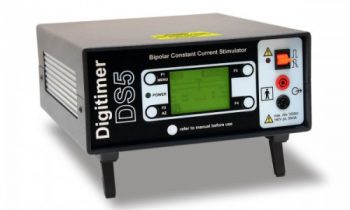Description
DESCRIPTION
The DS8R Biphasic Constant Current Stimulator is a new multi-mode, discrete pulse, constant current stimulator for human research studies involving nerve and muscle stimulation via surface electrodes. It features a high compliance voltage and can be triggered by a TTL compatible input, contact closure foot/hand switch or front panel “single-shot” button. The DS8R can deliver monophasic or biphasic pulses of up to 2ms duration, with an output range of 0-1000mA in 100µA steps (from 400V), however the actual current achieved will be restricted by a pulse energy limit of 300mJ per pulse and the skin/electrode resistance. Most importantly, the new DS8R incorporates features that allow external “on the fly” control of stimulus pulse parameters.
Optional Firmware for High Frequency (10kHz) Stimulation
A special edition firmware can also be provided for researchers interested in stimulating at higher frequencies (10kHz) than the standard unit permits. For example transcutaneous spinal cord stimulation (TSCS) protocols inspired by “Russian” stimulation” methods are possible with this optional firmware, allowing researchers involved in spinal cord injury research to examine the effects of TSCS on recovery of function.
Biphasic Charge-balanced Output
The DS8R Biphasic Constant Current Stimulator, has two pulse modes, enabling stimulation using monophasic or biphasic rectangular pulses. Additionally, in biphasic mode the DS8R allows for both symmetric or asymmetric charge-balanced stimuli through implementation of an adjustable stimulus/recovery phase amplitude ratio. Biphasic charge-balanced stimulation offers certain advantages over monophasic stimulation, as it prevents the potentially harmful electrochemical changes which occur under stimulation sites and is reported to be more comfortable for the subject during long periods of stimulation. The recovery phase ratio can be adjusted from 10% to 100% in 1% increments. As illustrated below, at 100% the two phases are identical in terms of duration and amplitude, but as the ratio is reduced from 100% the amplitude of the recovery phase decreases, while its duration is extended to preserve charge balancing.
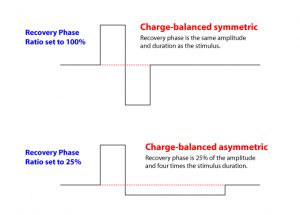 External Control Capabilities – Software (via USB) and Analogue Voltage Input
External Control Capabilities – Software (via USB) and Analogue Voltage Input
Researchers often want to adjust stimulus settings (current and duration) during a stimulation protocol and with the arrival of the DS8R, such control becomes a reality. While the DS8R can operate as a standalone isolated stimulator with full control via the front panel, settings can also be modified using Windows PC control software (supplied) via a USB interface. This software provides a Virtual Front Panel for the stimulator, but more importantly incorporates an API allowing the operator to implement control from custom or commercially available software packages, such as CED Signal/Spike2, Python or Matlab.
 Pulse current amplitude can be more simply controlled via an analogue voltage input (BNC) on the rear of the DS8R. Using this method of control, the DS8 monitors the voltage applied at this input (0-10V) and adjusts the stimulus current proportionally with this voltage as each trigger input is detected. Note that the control voltage signal does not define the shape of the output pulse, it is merely used as a proportional representation of the output stimulus current.
Pulse current amplitude can be more simply controlled via an analogue voltage input (BNC) on the rear of the DS8R. Using this method of control, the DS8 monitors the voltage applied at this input (0-10V) and adjusts the stimulus current proportionally with this voltage as each trigger input is detected. Note that the control voltage signal does not define the shape of the output pulse, it is merely used as a proportional representation of the output stimulus current.
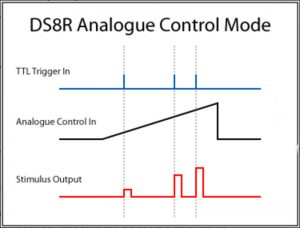 Designed for Demanding Human Research Applications
Designed for Demanding Human Research Applications
The DS8R is suitable and safe for human research applications, but because the maximum pulse energy of 300mJ exceeds the 50mJ limit imposed by international standards in relation to clinical evoked-potential stimulation devices , we are not seeking medical device certification for the DS8R.
GALLERY
PUBLICATIONS
Huys, A. M. L., Beck, B., Haggard, P., Bhatia, K. P., & Edwards, M. J. (2021). No increased suggestibility to placebo in functional neurological disorder. European Journal of Neurology, ene.14816. https://doi.org/10.1111/ene.14816
Adamczyk, W. M., Szikszay, T. M., Kung, T., Carvalho, G. F., & Luedtke, K. (2021). Not as “blurred” as expected? Acuity and spatial summation in the pain system. Pain, 162(3), 794–802. https://doi.org/10.1097/j.pain.0000000000002069
Latella, C., Pinto, M. D., Nuzzo, J. L., & Taylor, J. L. (2021). Effects of post-exercise blood flow occlusion on quadriceps responses to transcranial magnetic stimulation. Journal of Applied Physiology, japplphysiol.01082.2020. https://doi.org/10.1152/japplphysiol.01082.2020
Calloway, R., Karuzis, V., Tseng, A., & Martinez, D. (2020). Auricular Transcutaneous Vagus Nerve Stimulation (tVNS) Affects Mood and Anxiety during Second Language Learning. Annual Meeting of the Cognitive Science Society. cogsci.mindmodeling.org. Retrieved from https://cogsci.mindmodeling.org/2020/papers/0840/0840.pdf
Groeber, M., Stafilidis, S., Seiberl, W., & Baca, A. (2020). Contribution of Stretch-Induced Force Enhancement to Increased Performance in Maximal Voluntary and Submaximal Artificially Activated Stretch-Shortening Muscle Action. Frontiers in Physiology, 11. https://doi.org/10.3389/fphys.2020.592183
Alam, M., Ling, Y. T., Wong, A. Y. L., Zhong, H., Edgerton, V. R., & Zheng, Y. P. (2020). Reversing 21 years of chronic paralysis via non-invasive spinal cord neuromodulation: a case study. Annals of Clinical and Translational Neurology, 7(5), 829–838. https://doi.org/10.1002/acn3.51051
Al’joboori, Y., Massey, S. J., Knight, S. L., Donaldson, N. de N., & Duffell, L. D. (2020). The Effects of Adding Transcutaneous Spinal Cord Stimulation (tSCS) to Sit-To-Stand Training in People with Spinal Cord Injury: A Pilot Study. Journal of Clinical Medicine, 9(9), 2765. https://doi.org/10.3390/jcm9092765
Pandža, N. B., Phillips, I., Karuzis, V. P., O’Rourke, P., & Kuchinsky, S. E. (2020). Neurostimulation and Pupillometry: New Directions for Learning and Research in Applied Linguistics. Annual Review of Applied Linguistics, 40, 56–77. https://doi.org/10.1017/S0267190520000069
Taccola, G., Salazar, B. H., Apicella, R., Hogan, M. K., Horner, P. J., & Sayenko, D. (2020). Selective Antagonism of A1 Adenosinergic Receptors Strengthens the Neuromodulation of the Sensorimotor Network During Epidural Spinal Stimulation. Frontiers in Systems Neuroscience. ncbi.nlm.nih.gov. https://doi.org/10.3389/fnsys.2020.00044
Wu, Y. K., Levine, J. M., Wecht, J. R., Maher, M. T., LiMonta, J. M., Saeed, S., … Harel, N. Y. (2020). Posteroanterior cervical transcutaneous spinal stimulation targets ventral and dorsal nerve roots. Clinical Neurophysiology. Elsevier. https://doi.org/10.1016/j.clinph.2019.11.056
Villar Ortega, E., Anso, J., Bütler, K., & Marchal Crespo, L. (2019). High-frequency transcutaneous cervical electrical stimulation: A pilot study. Conference: 13th Vienna International Workshop on Functional Electrical Stimulation. Retrieved from https://www.researchgate.net/profile/Laura_Marchal-Crespo/publication/336126264_High-frequency_transcutaneous_cervical_electrical_stimulation_A_pilot_study/links/5f88348ba6fdccfd7b62b07a/High-frequency-transcutaneous-cervical-electrical-stimulation-A-pilot-study.pdf
Caplan, I., de Jager, K., Al’joboori, Y., Duffell, L., Vanhoestenberghe, A., & Loureiro, R. (2019). Stimulation induced biopotential amplifier saturation due to common mode voltage. BiomedEng 2019, 159. Retrieved from https://www.biomedeng19.com/conference-proceedings
Calvert, J. S., Manson, G. A., Grahn, P. J., & Sayenko, D. G. (2019). Preferential activation of spinal sensorimotor networks via lateralized transcutaneous spinal stimulation in neurologically intact humans. Journal of Neurophysiology, 122(5), 2111–2118. https://doi.org/10.1152/jn.00454.2019
Ben Hmed, A., Bakir, T., Garnier, Y., Binczak, S., & Sakly, A. (2017). A novel strategy for adjusting current pulse amplitude of FES-systems with PID based on PSO algorithm method to control the muscle force. ICINCO 2017 – Proceedings of the 14th International Conference on Informatics in Control, Automation and Robotics, 1, 664–669. https://doi.org/10.5220/0006473306640669
Last updated 6th April 2021
FAQS
The 300mJ/pulse limit is present in the EN 60601 international standard and is applicable to medical electrotherapy devices. While the DS8R is intended for research use only, we felt it was prudent to limit the DS8R to a pulse energy that could be applied to a comparable medical device.
No, the DS8R is a triggered pulse stimulator, so the output can only be rectangular in shape. If you need to stimulate with non-rectangular waveforms, please see our DS5 Bipolar Current Stimulator.
Early versions of the DS8R had a minimum pulse amplitude of 2mA, however, from March 2019, all DS8R’s offer a current range of 0-1000mA and can delivery stimuli in the range of sensory thresholds.
Yes, but because of the temporal unreliability of USB communication, we limit the frequency to no more than 10Hz when triggered by the button in the software or via the API.
5. I have seen reports of the DS8R being used for “Russian Stimulation” protocols, is this possible?
The standard DS8R can be triggered at a maximum frequency of 1000Hz, however, we have provided a modified firmware to some users which allows the DS8R to be triggered at 10kHz, allowing it to deliver bursts of biphasic pulses with 50us phase durations and <1us phase intervals. This has been employed for applications such as transcutaneous high frequency stimulation of the spinal cord, in order to research rehabilitation following spinal cord injury. Please contact us if you have an interest in this non-standard firmware.
The DS8R is supplied with our own Windows compatible Virtual Front Panel GUI software, which allows the user to control all settings accessible from the physical front panel, including triggering at up to 10Hz. As part of the software installation, an API is included which offers a basic but versatile programming interface to the DS8R. Third party control of the DS8R has been implemented by Cambridge Electronic Design (CED) in the latest versions of their Signal and Spike2 software and we also provide a Matlab solution in the downloads section of this page. Note that we have a web forum for hardware and software discussion.
While Digitimer does not have expertise in Python development, we do know of DS8R users who have implemented control. A solution developed by Hoyuong Doh, Woo-Young Ahn and Jaeyeong Yang (Seoul National University, Republic of Korea) enables control of the Digitimer DS8R Constant Current Stimulator using Python 3.5 or higher and 64-bit Windows machines. This repository is a Python porting of cocoanlab/DS8R_matlab, based on work by Dr. Choong-Wan Woo and Sungwoo Lee in the COCOAN laboratory.
Digitimer does not develop software for any platform other than Windows, but it may be possible to use a Windows emulator. If not, the DS8R does allow external control of triggering via a TTL/digital input and stimulus amplitude via an analogue input.
